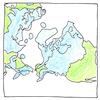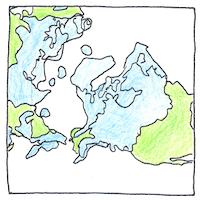Louis Agassiz
atmospheric sciences

|
Ice age
Rock beds and faces of rock show parallel grooves as though gravel locked in moving blocks of ice had scraped them. Unstratified beds of rounded gravel lay under topsoil as though they were produced by the trituration of sheets of ice moving over the surface. Rock debris arcs across the ends of valleys as if they were pushed only so far by glaciers. Slopes and summits are dotted with erratic rocks as if they were randomly dropped by retreating ice. Many people had suggested that the northern hemisphere had been covered with sheets of ice but it had not been scientifically established until Louis Agassiz put aside his work as an ichthyologist identifying species of fossil fishes and discussed these things with Jean de Charpentier and Karl Friedrich Schimper who had gotten their ideas from local inhabitants— a woodcutter and a chamois hunter. Agassiz made several trips to the alps with Charpentier and Schimper built a hut on one of the Aar glaciers made detailed observations of the ice supporting the theory— that before the elevation of the Alps vast sheets of ice extended from the North Pole southwards over northern Asia over North America and over Europe to the southern slopes of the Jura Mountains. Agassiz published Etudes sur les glaciers in two volumes giving no credit to Charpentier or Schimper and personally convinced the influential geologist William Buckland that ice once covered Scotland. Buckland then convinced other scientists. Thus the idea of the ice age was established.
Imagination of ice
The image of grand and gruesome sheets of ice covering our steep mountains and green valleys not once but five times captures the imagination. Strange mammals gone extinct— the mastadon and mammoth, the glyptodon, a Pleistocene armadillo, the smilodon, a saber-toothed cat, the megatherium, a sloth as big as an elephant— give us a larger and more dangerous world than the world we think we live in.
Ice cycles
Cycles of thawing and freezing hang icicles from eaves. Popsicles, Eskimo pies, and ice cream are as crude as frozen meat compared to ice in a bird bath forming a crystal sheet.



In the northern hemisphere, evidence of the ice age lie all about us, but it took someone with curiosity and imagination to see this because so much has changed since then, and because human hearts and minds are not sympathetic to that larger and more dangerous world. In addition to curiosity and imagination, Louis Agassiz also had the intelligence, passion, and persistence to document the effects sufficiently to convince others.
But there are limits. Agassiz resisted Darwin’s theories of evolution all his life.
See also in The book of science:
Readings in wikipedia: